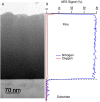High-Throughput Selection and Experimental Realization of Two New Ce-Based Nitride Perovskites: CeMoN3 and CeWN3
- PMID: 35965892
- PMCID: PMC9367680
- DOI: 10.1021/acs.chemmater.2c01282
High-Throughput Selection and Experimental Realization of Two New Ce-Based Nitride Perovskites: CeMoN3 and CeWN3
Abstract
Nitride perovskites have only been experimentally realized in very few cases despite the widespread existence and commercial importance of perovskite materials. From oxide perovskites used in ultrasonics to halide perovskites that have revolutionized the photovoltaics industry, the discovery of new perovskite materials has historically impacted a wide number of fields. Here, we add two new perovskites, CeWN3 and CeMoN3, to the list of experimentally realized perovskite nitrides using high-throughput computational screening and subsequent high-throughput thin film growth techniques. Candidate compositions are first down-selected using a tolerance factor and then thermochemical stability. A novel competing fluorite-family phase is identified for both material systems, which we hypothesize is a transient intermediate phase that crystallizes during the evolution from an amorphous material to a stable perovskite. Different processing routes to overcome the competing fluorite phase and obtain phase-pure nitride perovskites are demonstrated for the CeMoN3-x and CeWN3-x material systems, which provide a starting point for the development of future nitride perovskites. Additionally, we find that these new perovskite phases have interesting low-temperature magnetic behavior: CeMoN3-x orders antiferromagnetically below T N ≈ 8 K with indications of strong magnetic frustration, while CeWN3-x exhibits no long-range order down to T = 2 K but has strong antiferromagnetic correlations. This work demonstrates the importance and effectiveness of using high-throughput techniques, both computational and experimental: they are integral to optimize the process of realizing two entirely novel nitride perovskites.
© 2022 The Authors. Published by American Chemical Society.
Conflict of interest statement
The authors declare no competing financial interest.
Figures







References
-
- Zakutayev A.; Bauers S. R.; Lany S. Experimental Synthesis of Theoretically Predicted Multivalent Ternary Nitride Materials. Chem. Mater. 2022, 34, 1418–1438. 10.1021/acs.chemmater.1c03014. - DOI
-
- Matar S. F.; Demazeau G. Potential existence of post-perovskite nitrides; DFT studies of ThTaN3. J. Solid State Chem. 2010, 183, 994–999. 10.1016/j.jssc.2010.03.002. - DOI
-
- Sarmiento-Pérez R.; Cerqueira T. F. T.; Körbel S.; Botti S.; Marques M. A. L. Prediction of Stable Nitride Perovskites. Chem. Mater. 2015, 27, 5957–5963. 10.1021/acs.chemmater.5b02026. - DOI
-
- Jung M.-C.; Lee K.-W.; Pickett W. E. Perovskite ThTaN3: A large-thermopower topological crystalline insulator. Phys. Rev. B 2018, 97, 121104.10.1103/PhysRevB.97.121104. - DOI
LinkOut - more resources
Full Text Sources
